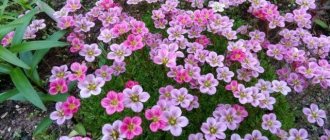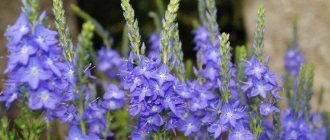A beautifully flowering ground cover plant that adorns the mountain slopes is saxifrage, a miniature representative of the green kingdom. Straight from the rocky slopes, saxifrage came to our gardens, taking root well in a variety of flower beds and, moreover, gaining unprecedented popularity among people interested in floriculture. The wide recognition of gardeners is based on several undeniable advantages of the flower: fast growth, unpretentiousness and, of course, natural beauty.
Delicate petals, colored white, pink or purple, thin miniature leaves, often reminiscent of moss. A thick green carpet of saxifrage can decorate any area, and its bright blooms will delight even the most sophisticated eye. But in order to successfully grow a beautiful ground cover in your flowerbed, it’s worth getting to know it better.
Saxifraga is a non-random name, being a literal translation of the Latin phrase saxifraga, consisting of two words (saxum - stone, rock and fragere - to destroy). The plant has other, less common, names, for example, gap-grass, femoral, dental.
This plant not only decorates gardens, it has a rich history. Here are some interesting and little-known facts about quarrying:
- Saxifraga oppositeifolia is a popular flower symbol in several territories, for example, the province of Nunavut (Canada), the city of Londonderry (Great Britain), and the province of Nordland (Norway).
- Saxifraga is a flower immortalized on the seal of the Japanese science city of Tsukuba.
- Some plant species are considered edible; in Southeast Asian countries, their leaves are fried in batter and eaten.
- Rupture-grass is also found in literary works; it is especially often mentioned by English poets and prose writers.
- The leaves of certain varieties are capable of secreting a substance such as lime, which gives their color a silver-gray tint.
- Traditional medicine considers some types of saxifrage to be medicinal plants that can heal colds and heart diseases, and help with urolithiasis. However, this perennial is not used in official medicine in any way.
According to the botanical classification, the genus Saxifraga (lat. Saxifraga) is one of the most numerous genera of the saxifrage family of the same name (lat. Saxifragaceae), uniting a group of herbaceous perennials. In addition, the genus contains annual and biennial species. All representatives of the genus have several common characteristics in common: small, most often round-shaped, leaves collected in a dense basal rosette and inflorescences consisting of small five-petaled flowers. Inflorescences, in this case, can be either paniculate or racemose. The height of saxifrage varies from 5 to 65 cm.
It is difficult to name the homeland of the unpretentious ground cover, because now the plant has spread throughout the globe: from the Japanese islands to the mountains of tropical regions of Africa. Under natural conditions, saxifrage can be seen in Russia; at least 125 species grow in the wild. Main distribution areas: Sakhalin, Kuril Islands, Caucasus Mountains. Some varieties are listed in the Red Book.
Most often, saxifrage can be found on rocky slopes. The plant prefers to live high in the mountains or on the foothills, especially in wooded areas or on the banks of streams. However, some species prefer wet meadows and valleys.
Saxifraga: varieties and varieties
The name of this beautiful herbaceous plant hints at the fact that saxifrage grows and develops even in hard-to-reach places. Its sophisticated bright flowers can easily destroy the strongest stones and “settle” in the resulting cracks. The Saxifraga family is diverse and multifaceted, it has about 200 species. The beauty and unpretentiousness of saxifrage contribute to their active use in modern landscape design. The most popular today are 2 types of these perennial plants.
Saxifraga is a very unusual and attractive plant for your garden.
Soddy saxifrage. It looks like a dense turf of rosettes with dissected leaves. This species does not bloom for long, only 3-4 weeks in June. For it, planting in slightly acidic open ground rich in humus will be optimal.
Soddy saxifrage
This type of saxifrage boasts the following varieties:
- Rose-koenigen (bright pink shade);
- Purpurmontel (purple color);
- Triumph (ruby red hue).
Arends saxifrage. This plant will delight you with its rich green color all year round. Its leaves form a continuous carpet up to 15 cm high. The flowering period is late spring - early summer.
Saxifraga Arends
The most popular varieties of this saxifrage:
- Peter Pan (bright red buds);
- Sleeping Beauty (red flowers);
- Floral Carpet (a scattering of pink and purple flowers);
- Snow carpet (white buds).
In addition, there are shadow, Manchurian, reed, paniculate, round-leaved, wicker and other types of saxifrage. Some of them can be seen in the photo.
Saxifraga rotundifolia
Running water
Obviously, it is extremely important to eliminate stagnant hydration. Not only general drainage and removal of moisture from the root collar are important. Even stagnation of water in rosettes is not acceptable for certain types of saxifrage. Therefore, it is optimal to plant saxifrages the way they grow in nature - obliquely in a crevice between stones . If for some reason this is not possible, the root collar of the plant should be mulched with gravel in a layer of at least 3 cm, and the soil underneath should be as loose as possible.
However, you should not go to extremes and think that a desert without a drop of water is suitable for saxifragas. In the mountains, even if there are periods without rain, differences in day and night temperatures, as well as evaporation from snowfields and glaciers, are such that dew and fog are regular there. This means that complete drying never occurs. This means that in the garden, saxifrage must be provided with at least a minimum amount of moisture. Its preservation in the soil is again facilitated by gravel mulch, and if there is no rain for months, you will have to start watering. Watering for future use will not work: even moisture-loving species require running water, but in stagnant water they become soaked.
Saxifraga care
Give these stunning perennials some love and care and they will reward you with fantastic blooms. They need regular watering in moderate doses, as well as fertilizing with fertilizers (once a month). The soil around plants should always be loose and weeded.
Saxifraga will feel very good in a rock garden or rock garden.
Stone rock gardens are often laid around saxifrage bushes, which serve as a kind of protective barrier for the roots from the scorching sun and help retain moisture.
When the saxifrage fades, the above-ground part of the plant is cut off. This procedure is necessary for the appearance of new leaves. These perennial plants tolerate the winter season well. If severe frosts occur, it is better to cover the saxifrage.
Proper cultivation of saxifrage involves several important nuances in care:
- avoid heat (create relative shade);
- provide flowing watering (make drainage).
The plant can thrive with minimal care.
We are creating special conditions: you will have to... move mountains!
Cushion-shaped saxifrages are inhabitants of mountains: crevices, caverns in stone, vertical walls. Their rigidity, hard protrusions, scaly structure, bluish color or powdery coating - all these are adaptations developed to reduce evaporation and withstand mountain solar insolation. The roots are designed in such a way that, on the one hand, they firmly hold the pillows in extreme conditions, and on the other hand, they are able to extract moisture and nutrients from the farthest crevices of the stone, in which it is most often stored.
But saxifrages are not used to the opposite: it is difficult for them to cope with excess moisture if it stagnates in the roots or around the root collar. They are not used to the summer heat: it is always cool in the mountains. So how can you please them?
Many quite winter-hardy saxifrages look amazing when planted in containers and require virtually no care other than watering. They are not afraid of prolonged freezing of the soil: in nature they often grow on cliffs completely devoid of snow. The place for saxifrage must be selected with special care; they simply will not grow in the garden bed.
Reproduction of saxifrage
Saxifraga is propagated in several ways. It is grown from seeds, new representatives are obtained by rosettes or by dividing the bush.
The culture is very easily propagated by rosettes
begin propagation by rosettes only after flowering has ended. To do this, the rosettes are very carefully separated from the bush, rooted in fertile soil, and then watered. For planting, you should choose a place that will be protected from the scorching sun. Only in spring are plants planted in open ground.
Another method of propagation involves obtaining seedlings after planting the seeds of the plant in open ground. The seeds are scattered on the surface of the nutrient substrate and lightly patted with the palm of your hand. The seedlings are picked and transplanted into peat pots. Seedlings are planted in open ground together with pots in June, maintaining a distance of 7 to 25 cm.
Such propagation methods will be simple for both experienced and novice gardeners.
Saxifraga seeds
Roots easily!
Once planted in a rock garden, the plant must be watered well, monitor soil moisture, and shade for a month while it takes root. It is better to transplant and plant saxifrages in early spring or September, when the sun is not too hot and the air humidity is more comfortable for them.
It is more convenient to propagate saxifrage by cuttings. Carefully cut off a piece of the pillow, which is disassembled into individual rosette shoots 1-2 cm long. All lower, especially blackened, leaves of the rosettes are torn off so that the lower half of the cutting is completely freed from organic matter. In boxes filled with such a mixture as for planting saxifrage, coarse sifted sand or fine gravel is poured on top with a 1 cm layer, and the cleaned part of the cutting is buried in this top layer. The cuttings are placed in a shady place under glass or film, constant air and soil humidity is maintained in it, it should not dry out. Different species produce roots at different speeds; there is no need to rush with seedlings. A clear sign of rooting will be the appearance of new side rosettes. It is better to take saxifrage cuttings after flowering, starting at the end of May, then they have more “race” to grow roots. But cuttings cut in August-September overwinter even without roots and take root the following spring.
Propagating saxifrage by seeds is quite a troublesome task. Some species sprout and grow easily and quickly (this applies primarily to Arends' saxifrage), while others will require long-term stratification, and in the first year only a single rosette will develop. General recommendations can be as follows: surface sowing at home in loose soil in December, after two weeks of sowing at room temperature - in the refrigerator for 6-8 weeks, then on a light windowsill, in a greenhouse until shoots appear. Further care is the same as for any seedlings, only with a discount for the extremely small size.
Advertising
Diseases and pests
Saxifraga is quite resistant to pests and diseases. However, unfavorable growing conditions or improper care can cause it to become infected or damaged by pests.
Dryness can cause damage to the plant by spider mites. In this case, a whitish web will be visible on the saxifrage. Later, the mite infects the leaves, they become covered with yellow spots, dry out and gradually die. Excessive moisture leads to the appearance of powdery mildew or damage to the leaves of the plant by rust, which is created by a variety of fungi.
Spider mite
The most dangerous pests for these perennial plants are scale insects and green aphids.
Mulching, loosening
Stagnant moisture is a problem that causes the roots and leaves of saxifrage to rot. It is useful to periodically loosen the soil around ground cover plants. A sufficient level of aeration has a positive effect on the growth of any flowers, including saxifrage.
Mulching is an effective method of retaining moisture. Interestingly, medium-sized stones are often used to cover the soil around plants. Under dense cover, weeds practically do not grow. Before forming a layer of mulch, be sure to moisten the substrate.
Saxifraga: combination with other plants
Growing saxifrage will bring you tremendous pleasure. All their varieties look very original and impressive, especially in combination with other plants. Irises, muscari and many other low-growing crops can share their proximity. Amazing combinations of saxifrage with lingonberries or Chinese-decorated gentian will help fill your exterior with beauty and originality.
Saxifraga in landscape design
Possible difficulties during cultivation
The only difficulty that gardeners have when growing saxifrage is the loss of decorative value due to overgrowth. Since the regrown shoots lose their leaves, which are located closer to the ground and the soil is visible through them. Therefore, when caring for the crop, it is necessary to pay attention to renewing the bushes and dividing them using cuttings. Also, so that the plant does not lose its decorative effect, faded flowers need to be broken off along with the peduncle at the base of the turf.
Saxifraga in landscape design
With its mesmerizing beauty, saxifrage has earned its rightful place in modern landscape design. It is placed in rock gardens, on artificial slides, embankments and rocks, where it looks very stylish and impressive. This plant will instantly turn an empty and unattractive rocky place into a chic flower garden. The richness of its varieties and shades will fill the surrounding space with bright, rich colors. That is why saxifrage is absolutely irreplaceable for landscape design.
Don't overfeed!
The soil should be granular, moisture-absorbing and permeable. Somewhere inside the rock garden or at the bottom of the container there may be a rather nutritious layer, where the saxifrage will eventually reach with its roots. But overfeeding risks that the plant tissues will become too loose and some kind of putrefactive infection will penetrate into them. Therefore, it is better not to feed saxifrages at all than to overfeed, and the soil mixture should consist of two-thirds granular components (limestone gravel, coarse sand, vermiculite) and only one-third be nutritious (clay, black peat and humus). Nitrogen fertilizers are contraindicated for saxifrage; this element is best given as part of complex fertilizers. You can use superphosphate, or you can add organic substances, such as bone meal and blood meal.
Some types of saxifrage are so difficult to cultivate that collectors grow them in alpine greenhouses, where all the required conditions are maintained. Special rock gardens are also created for saxifrages, the best stone for which is considered to be calcareous tuff-travertine, which is very hygroscopic.











